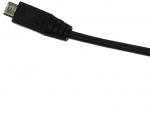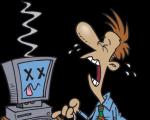Lesson on the topic of capacitors with presentation. Presentation on the topic capacitor. Variable capacitor








Currently, paper capacitors are widely used for voltages of several hundred volts and a capacity of several microfarads. In such capacitors, the plates are two long strips of thin metal foil, and the insulating spacer between them is a slightly wider paper strip impregnated with paraffin. One of the covers is covered with paper tape, then the tapes are tightly rolled into a roll and placed in a special case. Such a capacitor, having the size of a matchbox, has a capacity of 10 μF (a metal ball of such capacity would have a radius of 90 km).

In radio engineering, mica capacitors of small capacity (from tens to tens of thousands of picofarads) are used. In them, sheets of staniol are laid with mica so that all the odd sheets of staniol, connected together, form one plate of the capacitor, while the even sheets form another plate. The appearance and individual parts of such a capacitor are shown in the figure. These capacitors can operate at voltages ranging from hundreds to thousands of volts.

Recently, mica capacitors in radio engineering have begun to be replaced with ceramic ones. The dielectric in them is special ceramics. The linings of ceramic capacitors are made in the form of a layer of silver applied to the surface of the ceramic and protected with a layer of varnish. Ceramic capacitors are manufactured with capacities ranging from units to hundreds of picofarads and voltages from hundreds to thousands of volts.

So-called electrolytic capacitors are widely used, in which the dielectric is a thin oxide layer on the surface of aluminum or tantalum, which is in contact with a special electrolyte. These capacitors have a large capacity (up to several thousand microfarads) with small sizes.

Variable capacitors with air or solid dielectric are often used. They consist of two systems of metal plates insulated from each other. One system of plates is stationary, the second can rotate around an axis. By rotating the moving system, the capacitance of the capacitor is smoothly changed.


Municipal autonomous educational institution
"Lyceum No. 7" Berdsk
Capacitors
8th grade
Physics teacher
I.V.Toropchina

Capacitor
Capacitor- This is a device designed to accumulate electrical charge and electric field energy.

Capacitor
Capacitor represents two
conductor (plate), separated by a layer
dielectric, the thickness of which is small
compared to the size of the conductors.

The entire electric field is concentrated inside the capacitor and is uniform.
Capacitor charge is the absolute value of the charge on one of the capacitor plates.


- by type of dielectric : air,
mica, ceramic,
electrolytic. - according to the shape of the linings : flat,
spherical, cylindrical. - by capacity size:
constants, variables.

- Depending on their purpose, capacitors have different designs.

- A conventional technical paper capacitor consists of two strips of aluminum foil, insulated from each other and from the metal casing by paper strips impregnated with paraffin. Strips and ribbons are tightly rolled into a small bag

Variable capacitors

Capacitor designation
Fixed capacitor
Variable capacitor

Electrical capacity
A physical quantity characterizing the ability of two conductors to accumulate an electric charge is called electrical capacity, or capacitance.

When the charge increases by 2, 3, 4 times, respectively, by 2, 3, 4
the readings of the electrometer will increase times, i.e. it will increase
voltage between the capacitor plates.
The charge to voltage ratio will remain
permanent:

Capacitance of the capacitor
- The quantity measured by the charge ratio ( q) one of the capacitor plates to voltage ( U) between the plates is called electrical capacity of the capacitor .
- The electrical capacity of the capacitor is calculated by the formula:
C=q/U

Units of electrical capacity
Electrical capacity is measured in farads (F)
[ WITH ] = 1F (farad)
The electrical capacity of two conductors is numerically
is equal to one if, when imparting charges to them
+1 C and -1 C there is a difference between them
potentials 1V
1F = 1Kl/V

Units of electrical capacity
1 µF (microfarad) = 10 -6 F
1 nF (nanofarad)=10 -9 F
1 pF (picofarad) = 10 -12 F


- The larger the area of the plates, the greater the capacitance of the capacitor.
- As the distance between the plates of the capacitor decreases and the charge remains constant, the capacitance of the capacitor increases.
- When a dielectric is added, the capacitance of the capacitor increases.
The capacitance of the capacitor depends on the area of the plates, the distance between the plates, and the properties of the added dielectric.

Electrical capacity
from geometric
conductor sizes
Depends
on the shape of the conductors and
their relative position
on electrical properties
environment between conductors

Capacitor energy
- In order to charge a capacitor, work must be done to separate positive and negative charges. In accordance with the law of conservation of energy, the work done A is equal to the energy of the capacitor E, i.e.
A = E,
where E is the energy of the capacitor.
- The work of the electric field of a capacitor can be found using the formula: A = qU cp ,
where U Wed is the average voltage value.
U Wed = U/2; then A = qU Wed = qU/2, since q = CU, then A = CU 2 /2.
- The energy of a capacitor with capacitance C is equal to:
W=CU 2 /2

- Capacitors can store energy for a long time, and when discharged, they release it almost instantly.
- The ability of a capacitor to accumulate and quickly release electrical energy is widely used in electrical and electronic devices, medical equipment (X-ray equipment, electrotherapy devices), in the manufacture of dosimeters, and aerial photography.


- Flash lamp is powered by the electric current of the capacitor discharge.
- Gas discharge tubes light up when the capacitor bank is discharged.
- Radio engineering .


First capacitor was invented in 1745 by a German lawyer and scientist Ewald Jurgen von Kleistom
First capacitor: one cover is mercury, the other cover is the experimenter’s hand holding the jar.

- Almost the same experiment and almost at the same time was carried out in the Dutch city of Leiden by university professor Pieter van Musschenbroek.
- Having charged the water and taken the jar in one hand, he touched the metal rod with the other hand, which served to supply the charge to the water. At the same time, Muschenbroek felt such a strong blow to his arms, shoulders and chest that he lost consciousness, and took two days to come to his senses.
- Van Musschenbroeck's experiment became very famous, so the capacitor became known as the "Leyden jar".

Homework
§ 54, Exercise 38




General purpose capacitors are capacitors used in most types of electronic equipment. No special requirements apply to capacitors of this type. Special purpose capacitors are all other capacitors. These include: pulse, high-voltage, starting, noise suppression, as well as other capacitors.

Fixed capacitors are capacitors whose capacitance is fixed and does not change during operation of the equipment. Variable capacitors - used in circuits where capacitance changes during operation are required. In this case, the capacitance can be changed in various ways: mechanically, by changing the control voltage, by changing the ambient temperature.

Unprotected capacitors are a type of capacitors that are not allowed to operate in conditions of high humidity. It is possible to operate these capacitors as part of sealed equipment. Protected capacitors - can operate in conditions of high humidity.

Non-insulated capacitors - when using this type of capacitors, they are not allowed to touch the equipment chassis with their housing. Insulated capacitors - have a well-insulated housing, which makes it possible to touch the equipment chassis or its live surfaces. Sealed capacitors - this type of capacitor uses a housing sealed with organic materials. Sealed Capacitors - These capacitors have a sealed housing, which eliminates the interaction of the internal structure of the capacitor with the environment.

Slide 1
Completed by: Dima Karetko, student 10 “A” Supervisor: Popova Irina Aleksandrovna, physics teacher Belovo 2011 Municipal educational institution “Secondary school No. 30 Belovo” Capacitors Miiproekt in physicsSlide 2
 Plan Introduction Capacitors Basic parameters of a capacitor Classification of capacitors Application of capacitors Conclusion Literature
Plan Introduction Capacitors Basic parameters of a capacitor Classification of capacitors Application of capacitors Conclusion Literature
Slide 3
 Introduction You can find a system of conductors of very high electrical capacity in any radio receiver or buy it in a store. It's called a capacitor. Now you will learn how such systems are structured and what their electrical capacity depends on.
Introduction You can find a system of conductors of very high electrical capacity in any radio receiver or buy it in a store. It's called a capacitor. Now you will learn how such systems are structured and what their electrical capacity depends on.
Slide 4
 Capacitors A capacitor is a two-terminal network with a certain capacitance value and low ohmic conductivity; device for storing electric field energy.
Capacitors A capacitor is a two-terminal network with a certain capacitance value and low ohmic conductivity; device for storing electric field energy.
Slide 5
 Basic parameters of a capacitor: 1) Capacity: capacitance appears in the designation of a capacitor, while the actual capacitance can vary significantly depending on many factors. Real capacity is determined by electrical properties. 2) Specific capacitance is called the ratio of capacitance to the volume (or mass) of a dielectric. 3) Rated voltage - the voltage value indicated on the capacitor at which it can operate under specified conditions during its service life while maintaining parameters within acceptable limits. 4) Polarity: Many oxide dielectric (electrolytic) capacitors operate only with the correct voltage polarity due to the chemical characteristics of the interaction of the electrolyte with the dielectric.
Basic parameters of a capacitor: 1) Capacity: capacitance appears in the designation of a capacitor, while the actual capacitance can vary significantly depending on many factors. Real capacity is determined by electrical properties. 2) Specific capacitance is called the ratio of capacitance to the volume (or mass) of a dielectric. 3) Rated voltage - the voltage value indicated on the capacitor at which it can operate under specified conditions during its service life while maintaining parameters within acceptable limits. 4) Polarity: Many oxide dielectric (electrolytic) capacitors operate only with the correct voltage polarity due to the chemical characteristics of the interaction of the electrolyte with the dielectric.
Slide 6
 Classification of capacitors Vacuum capacitors (plates without dielectric are in vacuum). Capacitors with gaseous dielectric. Capacitors with liquid dielectric. Capacitors with a solid inorganic dielectric: glass (glass-enamel, glass-ceramic), mica, thin-layer inorganic films. Capacitors with solid organic dielectric: paper, metal-paper, film. Electrolytic and oxide-semiconductor capacitors (Such capacitors differ from all other types primarily by their huge specific capacitance). Permanent capacitors are the main class of capacitors that do not change their capacity. Variable capacitors are capacitors that allow a change in capacitance. Trimmer capacitors are capacitors whose capacitance changes during one-time or periodic adjustment.
Classification of capacitors Vacuum capacitors (plates without dielectric are in vacuum). Capacitors with gaseous dielectric. Capacitors with liquid dielectric. Capacitors with a solid inorganic dielectric: glass (glass-enamel, glass-ceramic), mica, thin-layer inorganic films. Capacitors with solid organic dielectric: paper, metal-paper, film. Electrolytic and oxide-semiconductor capacitors (Such capacitors differ from all other types primarily by their huge specific capacitance). Permanent capacitors are the main class of capacitors that do not change their capacity. Variable capacitors are capacitors that allow a change in capacitance. Trimmer capacitors are capacitors whose capacitance changes during one-time or periodic adjustment.
Slide 7
 Application of capacitors Capacitors are used to build various circuits with frequency-dependent properties. When a capacitor is quickly discharged, a high-power pulse can be obtained, for example, in photo flashes. Since a capacitor can retain a charge for a long time, it can be used as a memory element or an electrical energy storage device. In industrial electrical engineering, capacitors are used to compensate reactive power and in higher harmonic filters. Measuring transducer (MT) of small displacements: a small change in the distance between the plates has a very noticeable effect on the capacitance of the capacitor. IP of air humidity (a change in the composition of the dielectric leads to a change in capacitance) IP of wood humidity In relay protection and automation circuits, capacitors are used to implement the logic of the operation of some protections.
Application of capacitors Capacitors are used to build various circuits with frequency-dependent properties. When a capacitor is quickly discharged, a high-power pulse can be obtained, for example, in photo flashes. Since a capacitor can retain a charge for a long time, it can be used as a memory element or an electrical energy storage device. In industrial electrical engineering, capacitors are used to compensate reactive power and in higher harmonic filters. Measuring transducer (MT) of small displacements: a small change in the distance between the plates has a very noticeable effect on the capacitance of the capacitor. IP of air humidity (a change in the composition of the dielectric leads to a change in capacitance) IP of wood humidity In relay protection and automation circuits, capacitors are used to implement the logic of the operation of some protections.
MAOU Gymnasium No. 1
Presentation on physics in 10th grade
"Capacitors"
Physics teacher
I qualification category
Belogorsk, Amur Region
Elena Nikolaevna Klimenko Physics teacher Presentation on the topic “Lens” Grade 11 Municipal educational institution secondary school with in-depth study of individual subjects No. 1 Belogorsk, Amur Region

CAPACITOR – two conductors (plates) separated by a dielectric layer, the thickness of which is small compared to the size of the conductors.
WITH- electrical capacity (the ability of two conductors to accumulate electrical charge).
C=q/U q- charge, U- voltage
In SI, electrical capacity is measured in F (farad), 1F = 1 C/V

Capacitance of the capacitor depends from:
- distance between plates –d(m),
- plate area –S(m),
- depending on the type of dielectric – ε (dielectric constant of the medium).
C =εέS/d
έ – electrical constant


Based on the type of dielectric, capacitors are divided into:
- Vacuum
- Gaseous
- Liquid
- Glass
- Mica
- Ceramic
- Paper
- Electrolytic
- Oxide semiconductor

Methods for connecting capacitors:
- sequential
2) parallel

Capacitors are distinguished by the possibility of changing their capacitance :
- permanent capacitors - capacity does not change
- variable capacitors - the capacity changes during the operation of the equipment
- Trimmer capacitors – the capacity changes during one-time or periodic adjustment and does not change during operation of the equipment

Energy of a charged capacitor determined by the formula:
Si: [W] = J

Name
Capacity
Flat capacitor
Scheme
Cylindrical capacitor
Spherical capacitor
Application of capacitors :
- Capacitors (together with inductors and/or resistors) are used to construct various circuits with frequency-dependent properties, in particular, filters, chains feedback , oscillatory circuits and so on.
- When a capacitor is quickly discharged, a high power pulse can be obtained, for example, in photo flashes , electromagnetic accelerators , optically pumped pulsed lasers , Marx generators, (GIN; GIT) , generators Cockcroft-Walton and so on.
- Since a capacitor is capable of retaining a charge for a long time, it can be used as an element memory or electrical energy storage devices.
- Liquid level meter. A non-conducting liquid fills the space between the plates of the capacitor, and the capacitance of the capacitor varies depending on the level
- Measuring transducer (MT) of air humidity, wood (a change in the composition of the dielectric leads to a change in capacitance).
- Capacitors are able to accumulate a large charge and create high voltage on the plates, which is used for acceleration charged particles or to create short-term powerful electrical discharges

Literature sources:
1.Handbook of physics. H. Kuhling., Moscow “Mir”, 1983.
2. Textbook on physics 10th grade G.Ya.Myakishev. , B.B. Bukhovtsev., N.N. Sotsky. 2004.




